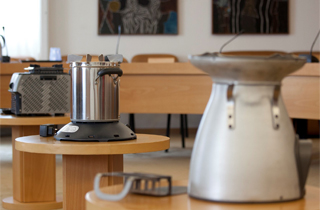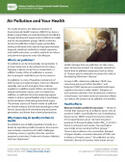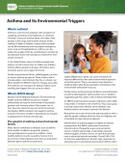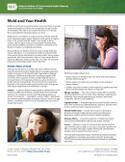Introduction

We tend to think of air pollution as a risk faced outside, but the air we breathe indoors can also be polluted. Smoke, vapors, mold, and chemicals used in certain paints, furnishings, and cleaners can all affect indoor air quality and our health.
Buildings affect overall well-being because most people spend most of their time inside. The U.S. Environmental Protection Agency estimates Americans are indoors 90% of their time – in built environments such as homes, schools, workplaces, places of worship, or gyms.
Environmental health researchers study how indoor air quality affects human health and well-being. Studies suggest that indoor concentrations of air pollutants are increasing, driven by factors such as the types of chemicals in home products, inadequate ventilation, hotter temperatures, and higher humidity.
Indoor air quality is a global issue. Both short- and long-term exposure to indoor air pollution can cause a range of health issues, including respiratory diseases, heart disease, cognitive deficits, and cancer. As one prominent example, the World Health Organization estimates 3.8 million people worldwide die every year from illnesses attributable to harmful indoor air from dirty cookstoves and fuel.
Certain populations may be affected more than others. Children, older adults, individuals with preexisting conditions, Native Americans, and households of low socioeconomic status are often exposed to higher levels of indoor pollutants.
Types of Pollutants

Many factors contribute to poor indoor air quality. Indoor air includes pollutants that penetrate from the outdoors, as well as sources that are unique to the indoor environment. These sources involve:
- Human activities within buildings, such as smoking, burning solid fuels, cooking, and cleaning.
- Vapors from building and construction materials, equipment, and furniture.
- Biological contaminants, such as mold, viruses, or allergens.
Some contaminants are described below:
- Allergens are substances that can trigger the immune system, causing an allergic reaction; they can circulate in air and remain on carpets and furniture for months.
- Asbestos is a fibrous material formerly used for making incombustible or fireproof building materials, such as roof shingles, siding, and insulation. Disturbing asbestos minerals or asbestos-containing materials can release fibers, often too small to see, into the air. Asbestos is known to be a human carcinogen.
- Carbon monoxide is an odorless and toxic gas. It is found in fumes produced any time you burn fuel in cars or trucks, small engines, stoves, lanterns, grills, fireplaces, gas ranges, or furnaces. Proper venting or exhaust systems prevent build up in the air.
- Formaldehyde is a strong-smelling chemical found in some pressed wood furniture, wood particle cabinets, flooring, carpets, and fabrics. It can also be a component of some glues, adhesives, paints, and coating products. Formaldehyde is known to be a human carcinogen.
- Lead is a naturally occurring metal that has been used in a wide variety of products including gasoline, paint, plumbing pipes, ceramics, solders, batteries, and even cosmetics.
- Mold is a microorganism and type of fungus that thrives in damp places; different molds are found everywhere, indoors and outside.
- Pesticides are substances used to kill, repel, or control certain forms of plants or bugs that are considered to be pests.
- Radon is a colorless, odorless, naturally occurring gas that comes from the decay of radioactive elements in soils. It can enter indoor spaces through cracks or gaps in buildings. Most exposures occur inside homes, schools, and workplaces. EPA estimates radon is responsible for about 21,000 U.S. deaths from lung cancer annually.
- Smoke, a byproduct of combustion processes, such as from cigarettes, cookstoves, and wildfires, contains toxic chemicals like formaldehyde and lead.
What is NIEHS Doing?
NIEHS supports research on the health effects of indoor air pollutants, such as those listed above, found in homes, schools, and workplaces. Because individuals move between indoor and outdoor environments, researchers are also developing specialized technologies to measure and collect data on personal exposures.
Respiratory Disease

- Actions to reduce mold exposure in early life may have long-term health benefits, potentially decreasing prevalence and severity of asthma.
- Among inner-city children with asthma who live in homes with high levels of indoor air pollution, those children with sufficient vitamin D levels had fewer symptoms.
- Household air pollution exposure likely affects lung development prenatally. Indoor air pollution exposure during pregnancy was associated with impaired lung function in infants. This altered infant lung function may then increase risk for pneumonia in the first year of life.
- Outdoor air quality can affect indoor air. Air pollution levels have been trending downward over several decades in southern California, due to air quality-control policies. These improvements in air quality are associated with improved lung development in children.
- The school environment contributes to childhood asthma illness. A study found that airborne mouse allergens in inner-city schools are linked to increased symptoms and decreased lung function in asthmatic children. School-based environmental interventions may be beneficial for curbing the public health problem of childhood asthma.
Cardiovascular Disease
- A study partially supported by NIEHS found that markers of cardiovascular disease risk appear when ozone levels are even lower than current EPA air quality standards. In healthy adults, exposure to short-term indoor and outdoor ozone was linked to increased blood platelets, a risk factor for clotting, and increased blood pressure.
Cognitive Effects
- Indoor exposures to air pollutants, including particulate matter, allergens, oxides of nitrogen, endotoxin, and mold, have been associated with impaired health and performance in children and adults.
- Characterization of indoor air pollution in schools is a public health concern for children, given the large amount of time spent there. Some inner-city schools exceeded WHO guidelines for interior air quality, particularly for nitric oxide, an indoor air pollutant that can affect cognitive outcomes, verbal abilities, and executive functioning. Physical defects and lack of proper ventilation contributed to the poor air quality in schools. The results suggest that improving building conditions and facilities, as well as consideration of the school’s outdoor surroundings, could create healthier environments.
- Office workers scored higher on performance measures when working in “green” environments with low indoor pollutants and low carbon dioxide levels.
- The air quality within an office can affect employees’ cognitive function, including response times and ability to focus, and it may also affect their productivity, according to NIEHS-funded research led by Harvard T.H. Chan School of Public Health.
Cancer
- Long-term exposure to radon and other indoor air substances that increase the chance of developing lung cancer include secondhand smoke, asbestos, arsenic, and some forms of silica and chromium.
- Indoor air contaminants, such as the carcinogen formaldehyde, exceed acceptable levels in some early childhood learning centers.
Community Involvement
NIEHS grant recipients work directly with communities affected by indoor air pollution to help reduce exposures and improve quality of life. Examples follow.
Citizen Science
- Together with researchers at two NIEHS-funded core centers — the University of Kentucky Center for Appalachian Research in Environmental Sciences and the University of Cincinnati Center for Environmental Genetics — high school students developed and pilot-tested a family-centered home radon testing toolkit with the ultimate goal of preventing lung cancer.
- To enable community-based research, NIEHS-funded researchers invented a low-cost, portable sensor for detecting indoor pollutants. The development of such high quality and affordable real-time sensors provides new opportunities to conduct research and inform individuals or communities on daily health risks.
- Engaging youth as partners in environmental health research can motivate them to pursue careers in science, build self-esteem and leadership skills, and educate their communities. At the University of California, Berkeley, the Lifting Up Communities by Intervening with Research (LUCIR) study involved high school students in characterizing chemicals in household cleaning products and estimating exposures to those chemicals. They repeated the process with "green" cleaning products, and noted reductions in harmful chemicals. Then to educate their target audience of Latina household cleaning staff, they developed engaging videos about choosing safer cleaning products. Learn more in a podcast linked below.
Tribal Nations

- Hopi tribe members in the American Southwest identified indoor air quality, as well as arsenic in drinking water, as environmental exposures of concern. These perceptions derive from actual experiences with health problems such as cancer and asthma. Study authors emphasize including traditional values and practices in future interventions to reduce environmental health risks.
- Patricia Nez Henderson, M.D., vice president of the Black Hills Center for American Indian Health and a NIEHS-funded researcher, is working to create culturally-relevant smoking cessation and secondhand smoke reduction interventions in Lakota communities. Learn more from a podcast listed below.
- Residential burning of biomass for heat leads to elevated indoor levels of fine particulate matter (PM2.5) that often exceed health-based air quality standards. NIEHS-funded grant recipients are developing and testing low-cost, educational, and sustainable interventions for improving residential heating to reduce young children's risk of respiratory diseases in Native American communities.
Low- and Middle-income Countries (LMICs)

Examples of clean cookstoves
(Photo courtesy of U.S. Mission Geneva)
- NIEHS participates in the Household Air Pollution Intervention Network trial, a randomized controlled study of liquefied petroleum gas stove and fuel distribution to 3,200 households in four countries. The largest global source of indoor pollution, particularly in LMICs, comes from cooking and heating with solid fuels, including dung, wood, agricultural residues, and coal. Data from studies, such as this one, are needed to inform policies on interventions to reduce household air pollution among vulnerable populations.
- In LMICs, about 3 million infants and children younger than 5 years die every year from pneumonia, according to WHO. Exposure to household air pollution from burning biomass fuels was implicated in about a third of these cases. NIEHS has funded research related to cookstoves, which contributes to understanding health effects of this form of household air pollution.
- NIEHS also partnered with the American Thoracic Society, the European Respiratory Society, and the Global Alliance for Clean Cookstoves on an international workshop on respiratory health effects of household air pollution. The workshop task force concluded, in 2018, scientific evidence supports the potential to develop scalable solutions that can reduce these exposures and improve lives. Respiratory diseases from household air pollution are preventable for 2.8 billion people worldwide.
- Research, co-funded by NIEHS, shows that prenatal household air pollution exposure increased the chance of developing pneumonia in the first year of life. The authors concluded that clean-burning interventions, such as cookstoves, may be most effective when begun before children are born.
Further Reading
Stories from the Environmental Factor (NIEHS Newsletter)
- Better Air Quality May Lower Dementia Risk Among Older Women (August 2021)
- Indoor Air a Neglected Source of Chemical, Particulate Exposures (May 2021)
- Inhalation Exposures, Emerging Chemicals Addressed by NIEHS Scientists (May 2021)
- Watch Out for Radon! Podcast, Citizen Scientists Spotlight Health Risk (February 2021)
Press Releases
- NIEHS Earns WELL Building Rating Amid Pandemic (2021) – NIEHS is the first federal agency to achieve the International WELL Building Institute’s Health-Safety Rating.
Fact Sheets
Podcasts
- Engaging Youth in Research (2021) - The NIEHS-funded Center for the Health Assessment of Mothers and Children of Salinas (CHAMCAOS) shares experiences with youth-led research, what they have learned, and how the program prepares the next generation of environmental health leaders.
- Using Culturally Appropriate Messages to Promote Smoke-free Homes (2021) – NIEHS-funded researchers work with tribal communities to encourage smoke-free homes and improve health.
Additional Resources
- Addressing Air Pollution and Asthma (989KB) – NIEHS supported a translational research study that may lead to improved health for children suffering from asthma. The researchers found that certain agricultural practices contribute to poor air quality and asthma among children. The team combined high-efficiency particulate air (HEPA) cleaners and a home-based education program to reduce children’s exposure to pollutants in the home.
- Fungal Diseases webpage from the National Institute of Allergy and Infectious Diseases covers fungal diseases caused by a variety of fungi commonly found in the environment. You can inhale fungi spores, or they can land on you. As a result, fungal infections tend to start in the lungs or on the skin.
- Indoor Air in Homes and Coronavirus (COVID-19) is a how-to guide by the EPA on improving ventilation to preserve indoor air quality and halt the spread of COVID-19.
- Prescription for Prevention: Indoor Air is a resource for healthcare professionals developed by the Icahn School of Medicine at Mount Sinai through an NIEHS grant.
- The Inside Story: A Guide to Indoor Air Quality is a safety guide prepared by EPA and the Consumer Product Safety Commission with steps for reducing indoor air pollution in your home.





